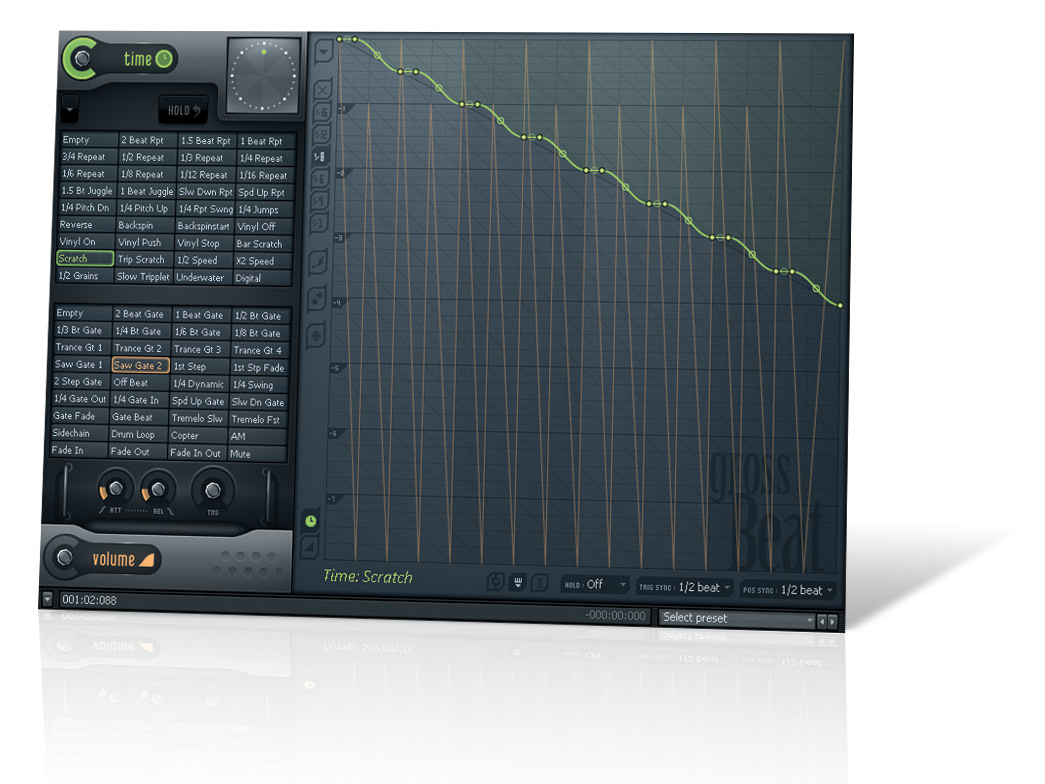MusicRadar Verdict
It's an acquired taste, but we suspect Gross Beat will please its target audience no end.
Pros
- +
Reasonably priced. Good degree of customisation. Fun to mess around with. Very focused concept Convincing scratching effects. Useful for both studio and live work.
Cons
- -
Not for everyone. The (less capable) competition is free.
MusicRadar's got your back
Gross Beat is by no means the first plug-in to emulate the functionality of turntables - in the past, instruments such as Bioroid Turntablist Pro and effects like dblue Glitch (both freeware) have aped the extreme pitch manipulation of audio made possible by record decks.
Image Line's plug-in takes the idea to a whole new level of complexity, though, with a sophisticated graphical user interface, volume as well as pitch control, and comprehensive live performance abilities.
The catch is that that's all Gross Beat does - you don't get any glitch effects here, just DJ-style volume and pitch manipulation. So, is it worth your $99, or would a free plug-in suffice?
In detail
The majority of Gross Beat's interface is taken up with the Envelope Mapping Panel, which is used to edit both the volume and playback position of the input audio signal, with icons for selecting Time or Volume mode.
Volume editing is the more straightforward of the two. The horizontal axis represents time - four beats to be exact, with no customisation possible. The vertical axis represents volume, with 100% at the top.
Points are created on the display by right-clicking the panel, and by default these snap to eighth-notes and jump from one value to another, rather than ramping smoothly.
However, it is possible to change the snap resolution or turn it off entirely, and also select a variety of shapes, including various curves with definable gradients.
Using the Volume mode of the Envelope Mapping Panel, you can emulate a DJ's use of a crossfader to create rapid on-off stutters and swift fades. This isn't a particularly sophisticated effect, but it comes into its own when combined with Gross Beat's Time manipulation mode.
With this engaged, the Envelope Mapping Panel's vertical axis represents time, with real-time at the top of the grid, and two bars earlier at the bottom. Any deviation from the top will result in the virtual record needle moving to some point into the past.
If you've used the Sample Offset parameter in Ableton Live's Clip Envelopes before, you'll be familiar with this concept.
A virtual 'spinback' is made possible by creating a steep slope that takes the virtual stylus to two bars earlier over the space of a single beat. Likewise, moving the record back and forth for scratching is doable and, when combined with crossfader-style volume patterns, can mimic the effect fairly realistically.
Alternatively, using stepped points, the beat can be played from different positions, making it easy to perform cut-up effects.
Live and direct
Gross Beat offers plenty of potential for those looking to utilise its audio-mashing effects on the stage. The Time and Volume processors have 36 pattern slots per patch, making it easy to swap between them on the fly.
This is done by clicking the relevant scene on the main interface, by striking a MIDI note, or by using MIDI CCs to scroll through the various modes on offer.
If using MIDI, Gross Beat can be instructed to return to the previous scene as soon as the note is released, to go back after a new pattern has played through once, or to simply stay on the selected patch - handy for creating live fills and variations.
It's also possible to control the wet/dry mix of both the volume and time effects, or even to use CC to manipulate the time offset parameter - 'scratching' with a knob on your MIDI controller! Using these features together, you can come up with effects that aren't possible with vinyl.
Summary
Gross Beat is, essentially, a basic effect that does a few simple things well, without going overboard. Yet, it's customisable and care has been taken to make sure that it's useful both live and in the studio.
So, if you think it sounds good on paper, you'll most likely find it lives up to your hopes. It's no replacement for a real turntable, though, so there's no need to stick your 1200s on eBay just yet.
Some examples of Gross Beat in action:
Computer Music magazine is the world’s best selling publication dedicated solely to making great music with your Mac or PC computer. Each issue it brings its lucky readers the best in cutting-edge tutorials, need-to-know, expert software reviews and even all the tools you actually need to make great music today, courtesy of our legendary CM Plugin Suite.
“The last thing Billy and I wanted to do was retread and say, ‘Hey, let’s do another Rebel Yell.’ We’ve already done that”: Guitar hero Steve Stevens lifts the lid on the new Billy Idol album
"This $399 item will incur over $578 in additional import charges": Price of Sonicware CyDrums drum machine more than doubles thanks to Trump tariffs
“For guitarists who crave an unrelenting, aggressive tone that stands out in any mix”: The Fortin Meshuggah head is the amp every metal player wants – now you can get its crushing tones in a pedal











